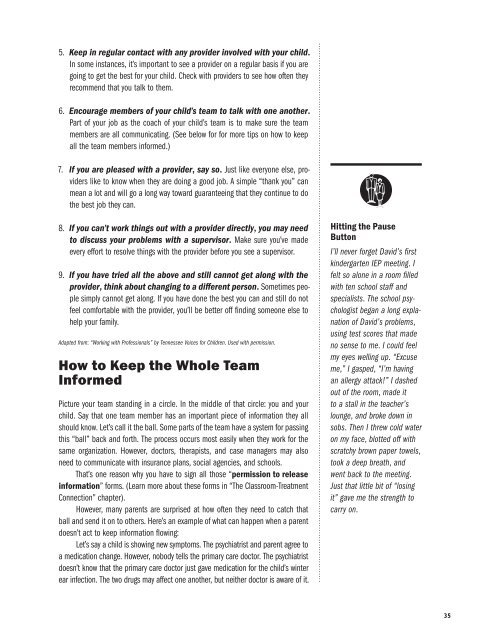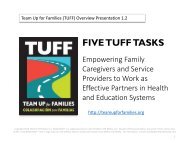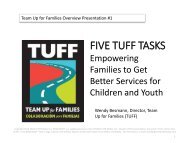Family Road Map Guide
Create successful ePaper yourself
Turn your PDF publications into a flip-book with our unique Google optimized e-Paper software.
5. Keep in regular contact with any provider involved with your child.<br />
In some instances, it’s important to see a provider on a regular basis if you are<br />
going to get the best for your child. Check with providers to see how often they<br />
recommend that you talk to them.<br />
6. Encourage members of your child’s team to talk with one another.<br />
Part of your job as the coach of your child’s team is to make sure the team<br />
members are all communicating. (See below for for more tips on how to keep<br />
all the team members informed.)<br />
7. If you are pleased with a provider, say so. Just like everyone else, providers<br />
like to know when they are doing a good job. A simple “thank you” can<br />
mean a lot and will go a long way toward guaranteeing that they continue to do<br />
the best job they can.<br />
8. If you can’t work things out with a provider directly, you may need<br />
to discuss your problems with a supervisor. Make sure you’ve made<br />
every effort to resolve things with the provider before you see a supervisor.<br />
9. If you have tried all the above and still cannot get along with the<br />
provider, think about changing to a different person. Sometimes people<br />
simply cannot get along. If you have done the best you can and still do not<br />
feel comfortable with the provider, you’ll be better off finding someone else to<br />
help your family.<br />
Adapted from: “Working with Professionals” by Tennessee Voices for Children. Used with permission.<br />
How to Keep the Whole Team<br />
Informed<br />
Picture your team standing in a circle. In the middle of that circle: you and your<br />
child. Say that one team member has an important piece of information they all<br />
should know. Let’s call it the ball. Some parts of the team have a system for passing<br />
this “ball” back and forth. The process occurs most easily when they work for the<br />
same organization. However, doctors, therapists, and case managers may also<br />
need to communicate with insurance plans, social agencies, and schools.<br />
That’s one reason why you have to sign all those “permission to release<br />
information” forms. (Learn more about these forms in “The Classroom-Treatment<br />
Connection” chapter).<br />
However, many parents are surprised at how often they need to catch that<br />
ball and send it on to others. Here’s an example of what can happen when a parent<br />
doesn’t act to keep information flowing:<br />
Let’s say a child is showing new symptoms. The psychiatrist and parent agree to<br />
a medication change. However, nobody tells the primary care doctor. The psychiatrist<br />
doesn’t know that the primary care doctor just gave medication for the child’s winter<br />
ear infection. The two drugs may affect one another, but neither doctor is aware of it.<br />
Hitting the Pause<br />
Button<br />
I’ll never forget David’s first<br />
kindergarten IEP meeting. I<br />
felt so alone in a room filled<br />
with ten school staff and<br />
specialists. The school psychologist<br />
began a long explanation<br />
of David’s problems,<br />
using test scores that made<br />
no sense to me. I could feel<br />
my eyes welling up. “Excuse<br />
me,” I gasped, “I’m having<br />
an allergy attack!” I dashed<br />
out of the room, made it<br />
to a stall in the teacher’s<br />
lounge, and broke down in<br />
sobs. Then I threw cold water<br />
on my face, blotted off with<br />
scratchy brown paper towels,<br />
took a deep breath, and<br />
went back to the meeting.<br />
Just that little bit of “losing<br />
it” gave me the strength to<br />
carry on.<br />
35














